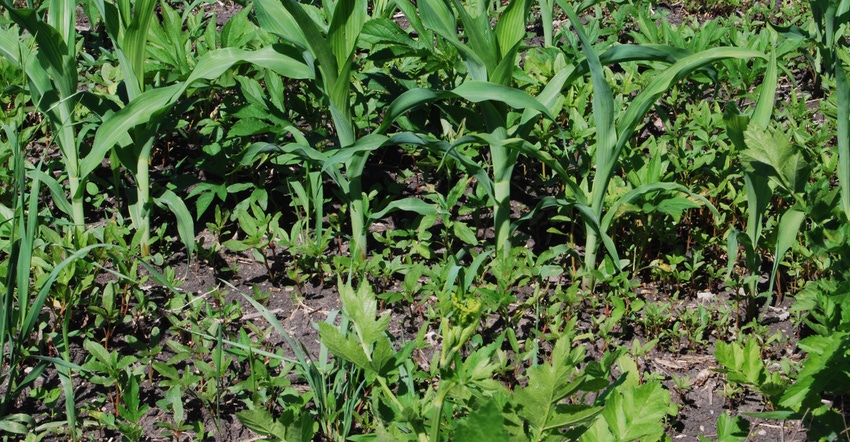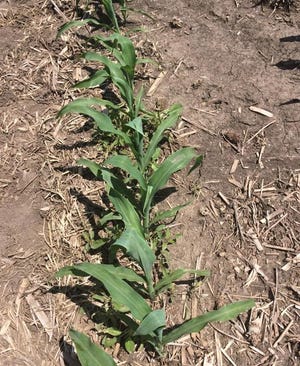April 13, 2020

In the rush of spring fieldwork, crop planting often takes priority over application of preemergence herbicides when time is crunched. Because of the availability of effective postemergence products, this approach has been effective for many farmers. But as multiple resistant weeds have become more prevalent, more attention is needed to maximize the efficacy of preemergence herbicides.
While most agronomists would prefer preemergence herbicide being applied immediately after planting, several strategies are available. “Regardless of strategy, it is imperative to get a preemergence herbicide on every acre,” says Bob Hartzler, Iowa State University Extension weed management specialist. Hartzler and ISU colleagues Meaghan Anderson and Prashant Jha provide the following overview of the pros and cons of different application strategies.
Early preplant application
These are herbicide applications made more than seven to 10 days prior to planting corn or soybeans.
Pros. These applications are typically completed before summer annual weeds begin to germinate, thus increasing the likelihood of timely activation by rainfall. These applications may provide a weed-free seedbed at planting. In no-till systems, they need to include a burndown product to control emerged winter annual and other weeds. The application is completed before planting, spreading the workload.
Cons. Residual herbicide activity on weeds into the growing season is shorter than when the product is applied near the crop planting date. Use of a layered residual herbicide approach reduces this risk. The layered residual approach is when you include a residual herbicide with a postemergence application.
Another con or possible disadvantage to consider is that final seedbed preparation tillage may “dilute” the early preplant herbicide within the soil profile if the tool is run too deep and may result in uneven distribution of the herbicide. Also, planter units may move herbicide out of the crop row, allowing weed escapes. And if planting is delayed, much of the value of the early preplant herbicide application may be lost.
Preplant, preemergence application
These applications are made within a week of planting — within a week before with preplant herbicides or a week after with preemergence products.
Pros. Herbicide product is applied near the time when summer annual weeds initiate emergence. Residual control is extended later into the growing season than early preplant herbicide applications.
Cons. If rain doesn’t occur within a week of planting, early-emerging weeds may escape control due to lack of herbicide activation. Also, planter units may move herbicide out of the crop row if applied preplant, allowing weed escapes.
Delayed preemergence application
These applications of herbicide are made more than a week after planting the crop.
Pros. Delayed preemergence applications may spread the workload. Residual control is extended into the growing season.
Cons. Herbicide options may be reduced if crop has emerged before application. Summer annual weeds likely will have emerged at application, requiring additional postemergence product to control these weeds. Rainfall is needed within a few days of the application to activate the product. Application delays can result in early-season competition between crops and weeds, and may allow weeds to exceed optimum size for postemergence control.
Maximize preemergence performance
“Preemergence herbicides are the foundation of herbicide-based weed management systems, and effective use of these products is essential to protect crop yields and reduce selection pressure for herbicide resistant weeds,” Hartzler says. “In a perfect world, applying preemergence herbicides immediately after planting would provide the greatest likelihood of maximum performance, but equipment and labor availability limit many farms from using this approach.”
 WEEDS IN ROW: Here’s an example of how waterhemp escaped in the crop row due to the preemergence herbicide being moved by row cleaners on the planter. (Photo by ISU)
WEEDS IN ROW: Here’s an example of how waterhemp escaped in the crop row due to the preemergence herbicide being moved by row cleaners on the planter. (Photo by ISU)

“Herbicide-resistant weeds have limited our ability to ‘rescue’ fields with postemergence treatments when weather delays the application of preemergence herbicides following planting,” Hartzler adds. “Thus, consider how you can ensure that all acres are protected with appropriate preemergence herbicide applications when prolonged wet weather periods or other factors interfere with field operations.”
Source: ISU, which is solely responsible for the information provided and is wholly owned by the source. Informa Business Media and all its subsidiaries are not responsible for any of the content in this information asset.
You May Also Like




